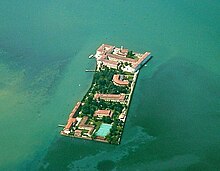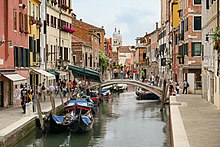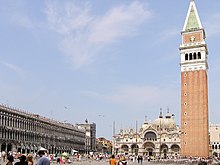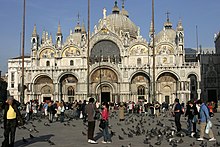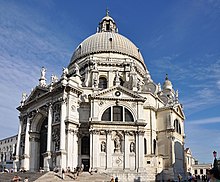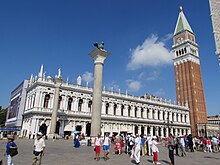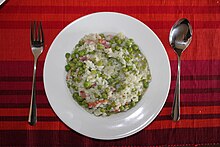Venice
Venice (in Italian Venezia [veˈnɛʦːi̯a] and in Veneto Venèsia [veˈnɛsi̯a]) is a city located in the northeast of Italy. It is also the capital of the Venetian region and of the province of Venice. Its historic center, declared a World Heritage Site by Unesco, is located on a group of islands in the Venetian lagoon, in the northern Adriatic Sea. Its geographical particularity, as well as its thousand-year history and its rich monumental and artistic heritage, have made Venice one of the most impressive and popular tourist destinations in the world.
The city is built on an archipelago of 118 small islands (if we include the islands of Murano, Burano and Torcello), almost all of them linked together by 455 bridges, and includes six districts or municipalità on the mainland (terraferma veneziana) where the majority of the population lives: about 60,000 inhabitants in the center of the island and 200,000 on the mainland. The center of Venice is reached by the Liberty Bridge, which gives access from the neighboring town of Mestre to Piazzale Roma. Inside the city there is no vehicle traffic, being, with the exception of navigation through the channels that separate the islands, a totally pedestrian city. Collective transport is carried out by ferry boats known as vaporettos. They are run by the municipal company ACTV.
Its canals make up a large network in the form of streets that start from the Grand Canal, a great road through which there is movement of a multitude of boats, large and small, the best known of which are the so-called gondolas.
Climate
According to the Köppen climate classification, Venice has a humid subtropical climate (Cfa), with cold winters and warm summers. The 24-hour average in January is 3.3 degrees Celsius (37.9 °F), and for July this figure is 23 degrees Celsius (73.4 °F). Precipitation is spread relatively evenly throughout the year with an average of 748 millimeters (29.4 in).
| Month | Ene. | Feb. | Mar. | Open up. | May. | Jun. | Jul. | Ago. | Sep. | Oct. | Nov. | Dec. | Annual |
|---|---|---|---|---|---|---|---|---|---|---|---|---|---|
| Average temperature (°C) | 6.6 | 8.6 | 12.5 | 16.1 | 21.5 | 24.9 | 27.7 | 27.5 | 23.5 | 18.0 | 11.6 | 7.4 | 17.2 |
| Average temperature (°C) | 3.4 | 4.7 | 8.3 | 12.0 | 17.1 | 20.5 | 23.0 | 22.6 | 18.9 | 13.8 | 7.8 | 4.0 | 13.0 |
| Temp. medium (°C) | −0.1 | 0.8 | 4.1 | 7.8 | 12.7 | 16.1 | 18.3 | 17.7 | 14.3 | 9.6 | 4.0 | 0.6 | 8.8 |
| Total precipitation (mm) | 47.0 | 48.3 | 48.8 | 70.0 | 66.0 | 78.0 | 63.9 | 64.8 | 72.0 | 73.5 | 65.5 | 50.6 | 748.4 |
| Precipitation days (≥ 1.0 mm) | 6.0 | 5.2 | 5.7 | 8.3 | 8.2 | 8.6 | 5.9 | 6.1 | 5.9 | 6.7 | 5.8 | 5.9 | 78.3 |
| Days of snowfall (≥ 1 mm) | 1.6 | 1.0 | 0.5 | 0 | 0 | 0 | 0 | 0 | 0 | 0 | 0.5 | 1.2 | 4.8 |
| Hours of sun | 80.6 | 107.4 | 142.6 | 174.0 | 229.4 | 243.0 | 288.3 | 257.3 | 198.0 | 151.9 | 87.0 | 77.5 | 2037.0 |
| Relative humidity (%) | 81 | 77 | 75 | 75 | 73 | 74 | 71 | 72 | 75 | 77 | 79 | 81 | 75.8 |
| Source No. 1: MeteoAM (sun and humidity 1961−1990) | |||||||||||||
| Source No. 2: Rivista Ligure "The neve sulle Cost of Maditerraneo (sic)" (Snow) | |||||||||||||
History
Venice was founded in the V century, taking advantage of its particular geography, which gave it protection against attacks by peoples Germans. Initially it was under the government of the Eastern Roman Empire, from which it gradually became independent.
For several centuries, constituted as a city-state, it specialized in navigation and developed maritime power that allowed it to dominate Mediterranean trade. Due to its location at the crossroads between great empires, it held a dominant position in trade with the kingdoms of China and India. Until 1797 it was the capital of the Republic of Venice (known as La Serenissima) and, with its 180,000 inhabitants, one of the most populous cities in Europe. Despite nominally constituting itself as a republic, the city was run by a kind of elective monarchy, the dux or doge, who, together with other government bodies, directed the life of the city and its possessions.
After a period of French (1805-1814) and Austrian (1797-1805 and 1814-1866) domination, Venice was incorporated into Italy in 1866. Since its founding, the city has suffered from periodic flooding. Currently the city faces a serious threat from repeated flooding. In spring and autumn the so-called acqua alta (high tide) takes place, twice a day, which completely floods Saint Mark's Square. The Italian government began in 2003 the construction of a system, called MOSE (Modulo sperimentale elettromeccanico), to erect mobile dikes that would close in the event of a rise in sea water level during acqua alta. It was tested on July 10, 2020 and on October 3 of the same year it was used for the first time to contain the floods suffered by the city.
Arts and culture
Venice is legendary for its extensive artistic heritage and long history as a benchmark for European painting. The wealth of the city's powerful (the Church, politicians and certain merchants) allowed them to maintain a prolonged patronage over painters, architects and other artists: from Gentile Bellini in the XV to Francesco Guardi at the end of the XVIII century, through Giovanni Bellini, Titian, Giorgione, Sebastiano del Piombo, Tintoretto, Veronese, Jacopo Bassano, Giambattista Tiepolo, among others. Curiously, many of these artists were born in other towns and came to Venice attracted by its strength.
The style of the successive Venetian painters maintained some common characteristics (warm and rich colors) that radiated their influence throughout half of Europe. The so-called «Venetian School» influenced masters as diverse as Rubens and Velázquez, and was instrumental in the genesis of Baroque painting in the 17th century. .
The city's architecture experienced a particularly brilliant period during the Renaissance, with architects such as Mauro Codussi, Pietro Lombardo, author of beautiful churches, and Jacopo Sansovino, who built the monumental Biblioteca Marciana. Andrea Palladio and Vincenzo Scamozzi also left notable works in Renaissance Venice. Later, Baldassare Longhena will stand out.
Antonio Vivaldi, one of the pinnacles of Baroque music, was born in Venice on March 4, 1678. Another of the greats of music, Richard Wagner, died in the city on February 13, 1883. Likewise, the great Although the composer Igor Stravinsky died in New York, he wanted his remains to be taken to Venice and today they rest in the San Michele cemetery. All this is a reflection of the importance of the city not only as the place of origin of many geniuses, but above all as an inexhaustible source of inspiration throughout history for poets, musicians, painters and all kinds of artists.
Venice is home to one of the world's most famous opera coliseums, the Teatro de La Fenice, which literally means "Phoenix Bird" and it lives up to its name, having risen from its ashes after repeated fires, the last one at the end of the XX century. It was the premiere venue for some of the most famous pieces in the repertoire, including several by Verdi.
The city was also the birthplace of famous writers such as Marco Polo (1254-1324) (although Marco Polo's birthplace is debated and it is suggested that he was born on the Croatian island of Korčula) and its famous book Il Milione. Giacomo Casanova (1725-1798) also stands out with his autobiography, Histoire de ma Vie ( Story of my life ), which links his lifestyle to the own city of Venice. In theater, playwrights who incorporated the Italian theater tradition of the Commedia del arte but using the Venetian dialect in their comedies stood out, such as Carlo Goldoni.
Since 1895 the city has hosted the Venice Biennale, a name normally used to refer to the Venice International Art Exhibition, which includes the Venice International Film Festival, born in 1932. Both events are the first and oldest of its kind that are still performed. Other events related to the Biennale are the Venice International Architecture Exhibition, the Theater Festival, the Contemporary Dance Festival and the Contemporary Music Festival. Due to its age and prestige, the Biennale is currently one of the most important contemporary art events in the world.
The immense cultural heritage of Venice, a summary of its millennial history, was recognized by Unesco with the distinction of World Heritage in 1987 for the historic center of the city and the lagoon.
Universities
Venice has several universities. The University Ca' Foscari, founded in 1868, is based in the Gothic Palace of the same name on the Grand Canal. This university offers courses in economics, commerce, languages, literature, philosophy, and natural sciences. It is organized into eight departments and four interdepartmental schools. During the 2012/2013 academic year, it had 18,829 students enrolled.
The other university in the city is the IUAV, a public university of architecture, design, theater, fashion, visual arts, urban planning and territorial planning. It has offices in Mestre and Treviso. The university of architecture founded in 1926 by Giovanni Bordiga, at that time president of the Venice Academy Gallery, was the second in Italy after that of Rome. Today it has three departments: Architecture, building and conservation, Project culture and the Department of design and planning in complex environments.
The Gallery of the Academy of Venice, founded on September 24, 1750 by will of the Senate of the Republic of Venice, has its main headquarters in the former Hospital for the Incurables. Other venues are on the island of San Servolo and at the Villa Manin di Passariano in Codroipo. Some of the famous artists who taught here were: Piazzetta, Tiepolo, Hayez, Nono, Ettore Tito, Arturo Martini, Alberto Viani, Carlo Scarpa, Afro, Santomaso, Emilio Vedova and Riccardo Schweizer.
In 1995, Venice International University was founded as a consortium of five Italian universities and two Italian institutions. Since then it has grown to gather sixteen members, including the Autonomous University of Barcelona, Duke University and Boston College. It offers university courses, intensive seminars, extracurricular and cocurricular activities during the two academic semesters (fall and spring) and summer schools; held every year and open to students from member universities.
Venice is the only Italian city with an ecclesiastical faculty of Canon Law, "Saint Pius X". Its current conformation is due to a decree of the Congregation for Catholic Education in 2008. Commissioned by the then patriarch, Cardinal Angelo Scola, the faculty is located in the restored building of the Patriarchal Seminary, next to the Basilica of Santa Maria della Hello. It is part of the academic pedagogical center Studium Generale Marcianum, which also includes the Higher Institute of Religious Sciences "L. Giustiniani", affiliated with the Triveneto Faculty of Theology.
In 1876 the Benedetto Marcello Conservatory was founded, located in Palazzo Pisani Moretta since 1940. In Mestre is the headquarters of the nursing course of the University of Padua and the IUAV Construction Sciences Laboratory.
Venice Carnival
Without a doubt, the most popular party in Venice is Carnival. It was officially declared a supreme holiday during the 13th century. However, it was in the 18th century that the Venetian carnival reached its peak. Travelers and aristocrats from all over Europe came to it, in search of fun and pleasure. With the decline of Venice as a merchant and military power, the carnival paled almost to nothing. It recovered somewhat at the end of the XX century, with the massive arrival of tourists to the city, although the great times of unbridled fun they were left behind
For centuries, the carnival was the escape route for citizens to escape the great control of the Venetian government. With the occupation of Venice by Napoleon's army, the carnival was prohibited for fear of conspiracies, taking advantage of the incognito. It did not recover until 1979. During the ten days that it lasts, people dress up and go out into the streets to walk and take photos, either in organized or impromptu parades. Mostly, the costumes are elaborate colorful period costumes from the Venetian XVII century, imitating the models of ancient paintings and covering the face with highly decorated masks, which have become one of the symbols of the city. During the carnival many events and parties are also organized.
Transportation
Channels
In Venice, collective transport (vaporetto) is very useful. In the old part of the center the only means of travel are private boats, taxis (high cost boats) and traghetti: boats very similar to a gondola but without decoration, which act as a bridge in various points of the Grand Canal.
The classic Venetian boat is the gondola, currently used mainly for tourists, weddings, funerals and other ceremonies. Most Venetians travel by vaporetto, which cover regular routes along the Grand Canal and between the various lagoon islands. In addition, many of them own boats or motorboats as a car.
Connection of the island with the mainland
Road transport can reach the city through the Liberty Bridge, a long pier across the Laguna Veneta equipped with a railway line and a highway that connect it with the mainland. Buses and private cars stop and park in Piazzale Roma, with the entrance to the city.
Streets
The numbering of the streets is by neighborhood or sestiere, and instead of being numbered street by street, each neighborhood is assigned a number series. The abundance and winding layout of streets, canals, alleys, lanes and patios make it difficult for the visitor to orient themselves. To avoid this, the roads and bridges are labeled with large signs and in many places there are signs indicating the direction to the most important landmarks: San Marco, Piazzale Roma (where the bus station is, at the entrance to the city), Rialto, Academy, etc.
Venetian street names still retain the nomenclature of the XI century, so they are different from the rest from Italian cities. Thus, there are canals (which logically are not considered streets, and if they are large they are called canale; and if they are narrow rio), streets (which, unlike the rest of Italy, where they are called via, here they are called calle), streets and quays that run alongside canals and rivers (called fondamenta), small streets flanked by houses and shops (called ruga or rughetta).
Other particular names are: the first streets to be paved are called salizada or salizzada; small alleys, called bouquets, dead-end streets, called cutting, important docking piers, called riva, streets that pass under buildings, called sotoportego and plazas (all called campo or campiello depending on their size, except for San Marcos, which does receive the adjective piazza, and that of the bus station, which, being smaller, is called piazzale).
Bridges over the Grand Canal
- Rialto Bridge. For many years he was the only one crossing the Grand Canal. Built by Antonio da Ponte at the end of the centuryXVI, is one of the most visited places in the city for its views over the canal, and the shops that flank it on both sides.
- Bridge of the Academy. It dates back to 1933.
- Puente de los Descalzos (Ponte degli Scalzi). Opened in 1934.
- Bridge of the Constitution, also called Fourth bridge or Calatrava Bridge. Opened in 2008.
Airports
| Airport | IATA Code | ICAO Code | |
|---|---|---|---|
 | Marco Polo International Airport | VCE | LIPZ |
 | Sant'Angelo Treviso Airport | TSF | LIPH |
Administrative organization
|  |
The historic city is divided into six areas or "sestiere". These are Cannaregio, Castello (including San Pietro di Castello and Sant'Elena), Dorsoduro (including the Giudecca and Sacca Fisola), San Marco (including San Giorgio Maggiore), San Polo and Santa Croce. Each sestiere was administered by a procurator and his staff. Today the sestiere are statistical and historical areas without any degree of autonomy.
These districts contain parishes (seventy in 1033, reduced in number by Napoleon, and today thirty-eight). These parishes were the precedent of the sestieri, which were created in 1170. Other islands in the Venetian lagoon are not part of any of the sestieri, having historically enjoyed a considerable degree of autonomy. Each sestiere has its own street numbering system, in which each house is assigned a unique number within the district.
Demographics
| Graphic of demographic evolution of Venice between 1861 and 2011 |
 |
Source ISTAT - Wikipedia graphics |
Heritage
Places
- Plaza de San Marcos
Napoleon Bonaparte said of this square that it was "the most beautiful hall in Europe". It is the only one in Venice that reaches the category of Piazza. The floor is made of Istrian stone slabs. The square is delimited by famous buildings: in the background, the façade of the Basilica of San Marco, the brick Campanile (from there the arrival of ships was signaled and fires warned), the Doge's Palace and Torre dell'Orologio. Delimiting the square with a length of almost 350 m are the two buildings called Old Prosecutors and New Prosecutors, whose facades are a continuous arcade.
The Procuratie Vecchie ('Old Procurator's Offices') building was the headquarters of the procurators and magistrates in charge of the upkeep of the Basilica. Built between the late 15th century and the early XVI, are to the right of it. On the opposite side are the Procuratie Nuove ('New Procurator's Offices'); Begun by Scamozzi at the end of the XVI century, they were completed by Longhena in 1640. At the end of the square, between these two buildings, admire the Fabbrica Nuova, today the Correr Museum. At the end of the building of the Old Prosecutors, in the north wing of the square, is the tower called Dell'Orologio or Los Moros; gives access to the neighborhood of Mercerías. In the center of it is a large clock that indicates the hours, the days and the course of the planets and stars. At the top you can see the figures known as Moors and who strike the hours by striking a bell. You can go up to the terrace where these are located.
The space in front of the Doge's Palace, immediately next to the Basilica, is known as Piazzetta, and is perhaps the heart of the city. Surrounded by buildings of various artistic styles, such as the Loghetta or portico to access the Campanile, the Library of San Marco, an imposing Renaissance building by Sansovino, and the Palazzo itself, opens onto the lagoon in a pier adorned by two large columns, with the Lion of Saint Mark, symbol of Venice, culminating in one, and Saint Theodore, ancient patron saint of the city, in the other. In the past, the square was a large grassy enclosure crossed by a river and bounded by two churches: San Teodoro and San Gemignano.
Palaces
- Palazzo Ducale, a Gothic building for the most part, located on the eastern end of St. Mark's Square, its two most visible facades look towards the Venice Lagoon and St. Mark's Square. The palace was the residence of the Dux, the seat of the government and the court of justice and prison of the Republic of Venice. Its main access is the Porta della Carta, an admirable piece of tardogotic sculptures, adjacent to the Basilica. Very sumptuous is the palace courtyard, with the Staircase of the GiantsSansovino. The interior retains part of the original rooms with rich pictorial collections.
- Ca' d'Oro. One of the most beautiful Venetian palaces, with characteristic Gothic facade of mixed arches, was built by the architect Bartolomeo Bon in the centuryXV, introducing shy Renaissance details in decoration and structure.
- Ca' Rezzonico. Imponent Baroque palace, work of Baldassare Longhena, who seemed to be inspired by the Library of Sansovino to compose the facade, exaggerating the decoration and the volumes. It houses the museum of the Venetian Baroque.
- Palazzo Dolfin Manin, built by Jacopo Sansovino for Giovanni Dolfin, Lord of Verona. In him lived the last Dogo of Venice, Ludovico Manin.
- Palazzo Fortuny, headquarters of the museum on the Spanish painter Mariano Fortuny and Madrazo.
- Palazzo Grassi, work of Giorgio Massari (1748). The restorers were Gae Aulenti and Antonio Foscari, who transformed him into a museum in 1986. It hosts major international exhibitions.
- Peggy Guggenheim Collection. Installed at the Palazzo Venier dei Leoni, or Palazzo Nonfinito, to remain unfinished his works in the centuryXVIII, it was acquired by the patron that bears its current name, assigning it to its collection of contemporary art, which includes excellent works by Picasso, Max Ernst (second husband of the founder), Pollock and Marino Marini, among others. It is one of the most important museums in Italy in its genre.
- Palazzo Contarini del Bovolo. Very well known for its spectacular exterior staircase in helicoidal form.
- Ca' Corner della Regina, headquarters of the Prada Foundation.
- Fondaco dei Turchi.
- Palazzi Barbaro.
- Palazzo Labia.
- Scuola Grande di San Marco.
- Palazzo Malipiero.
- Ca' Pesaro, masterpiece of the Baroque, work of Longhena. In it is the Museum of Modern Art.
- Ca' Tron.
- Palazzo Vendramin, Renaissance palace (1509) of geminated windows. Richard Wagner died in 1883.
- Ca' Dario.
- Ca' Foscari, headquarters of the homonymous university.
- Palazzo Savorgnan, centuryXVII, it is a secondary school; its gardens are public park.
Churches
- St. Mark's Basilica. Masterpiece of Byzantine architecture in the West, built to house the remains of the Evangelist Mark, brought from Alexandria, the present basilica dates from the centuryXI. It presents a complex Greek cross plant with a multitude of domes, very developed nartex and iconostasy. Highlights your airy Campanile, sign of identity of Venice, markedly separated from the body of the basilica and preceded by the LoghettaJacopo Sansovino's work. In the interior, the mosaics, of decidedly oriental air, and the Pala d'Oro, small altarpiece of gold filigree, enamels and precious stones.
- Basilica of Santa Maria Gloriosa dei Frari. Famous to house one of the masterpieces of Tiziano, the Assumption of the VirginIt is also one of the masterpieces of the Gothic style in the city.
- Basilica of Santa Maria della Salute (Santa Maria de la Salud). Masterpiece of the Venetian Baroque, was built by Baldassare Longhena with great sumptuousness, as a tribute of the city after the great plague of 1630. The great voluts that hold the dome are very original, and in the interior, the scenographic main altar.
- Basilica of Saint Giorgio Maggiore. Located opposite San Marcos Square, on the island of San Giorgio. It began the construction of the Palladio church in 1566, the facade is the work of Vincenzo Scamozzi that finished it in 1610. The brick campanile, in imitation of San Marcos, rose in 1791. Inside there are works of Tintoretto and a splendid sillery.
- Redentore Church. Situada overlooking the channel of the Giudecca, is one of the most debugging works of Palladio, which ended it in 1592.
- Church of San Zaccaria. It stands out for its beautiful façade, the work of Mauro Codussi, and for containing an important pictorial collection with works by Giovanni Bellini and Van Dyck, among others.
- Church of San Giovanni e Paolo. Gothic church built by the Dominicans between 1234 and 1430. Known as San Zanipolo in the Venetian dialect, it houses numerous graves of notable characters, including 25 dogos and those of the brothers Giovanni and Gentile Bellini, as well as several works by Paolo Veronese.
- Church of the Madonna dell'Orto, Gothic, where Tintoretto is buried.
- Church of San Giovanni in Bragora, church of pre-Romanic origin with Gothic facade. Here he was baptized Vivaldi.
- Church of San Rocco. Saves an important collection of Tintoretto paintings on the life of the patron saint, pattern of the Scuola annexa, which was one of the most outstanding Venetian institutions for centuries.
- Church of San Francesco della Vigna. Built by Jacopo Sansovino, it was finished by Palladio, who designed the facade, sober classicism.
- Church of San Salvador. Built by Tullio Lombardo and Sansovino, it preserves important paintings by Tiziano and Giovanni Bellini.
Other places of interest
- San Marcos Library. Sunny building built by Jacopo Sansovino in front of Palazzo Ducal, is one of the masterpieces of Renaissance architecture, notable for the classic harmony of its facades and the meticulous decoration that covers them. It houses an important collection of documents, as well as works by the most eminent Venetian painters.
- Arsenal of Venice. The largest industrial complex in Europe prior to the Industrial Revolution.
- Academy Gallery. It has its origin in the Academy of Arts founded in the centuryXVIII. This museum is perhaps the richest in Venetian painting in the world, together with the Museo del Prado in Madrid. Almost all the painters who worked or passed through Venice are represented, and some, like Giorgione or Titian, with some of their greatest creations.
- La Fenice Theatre. Inaugurated in 2003 after the last fire that destroyed it, the reconstruction faithfully reproduced the old theatre.
- Big Canal. It has 3800 m long, from 30 to 70 m wide and 5 m maximum depth. On their shores, they rise about 200 palazzosbuilt from the centuryXII Al XVIII. The Venetians call him the canalazzo. The smaller channels are called rii. It is crossed by four bridges, the oldest Rialto Bridge.
- Piombi. It is an old prison located in the attic of the Ducal Palace of Venice.
- Scuola Grande di San Rocco.
- San Moisè Theatre.
Sports
The most Venetian of sports is voga veneta or voga alla veneta, a rowing technique practiced in the Venetian lagoon in which the rowers stand upright in the boat, looking forward. An example of this is the way in which gondoliers row their boats.
The city's main soccer club is Venezia FC, founded in 1907 and currently playing in Serie A. The team plays its home games at the Stadio Pierluigi Penzo, located in the Castello sestiere, one of which is one of the oldest stadiums in Italy inaugurated in 1913.
The city's basketball club is Reyer Venezia Mestre, founded in 1872 as the Società Sportiva Costantino Reyer gymnastics club, and in 1907 as a basketball club. Reyer currently plays in Lega Basket Serie A. The team The men's team has been Italian champion in 1942, 1943, 2017 and 2019. Its stadium is the Palasport Giuseppe Taliercio, located in Mestre. The president of the club, Luigi Brugnaro, is also the mayor of the city.
Gastronomy
Among the various typical dishes are fish from the Adriatic Sea (the most typical are prawns, squid, Murano crabs or sardines), carpaccio with Parmesan cheese, Venetian liver, rice & #34;fisherwoman" and the "mandolato" (crispy almond nougat).
The most typical drink in the city is the spritz, a soft drink with alcohol, very traditional in the Veneto area. It can be taken with bitter. The crodino, a non-alcoholic drink, is also very typical; the prosecco, a sparkling wine; the bellini, a cocktail with wine and white peach juice; the "bussulai", a cinnamon-based drink, or the sgroppino, a liqueur with lemon sorbet, vodka and prosecco.
Twinned cities
Venice is twinned with the following cities:
- Basra (Irak)
- Caracas (Venezuela)
- Dubrovnik (Croatia)
- Yerevan (Armenia)
- Istanbul, Turkey
- Fort Lauderdale, United States
- Nuremberg (Germany, cooperation agreement)
- Sarajevo, Bosnia and Herzegovina
- Shenzhen (China)
- Panama City (Panama)
- Tallinn (Estonia)
- Xochimilco (Mexico)
- Thessaloniki (Greece, cooperation agreement)
- Resistance (Argentina)
In popular culture
The city of Venice has been the subject of multiple works in all artistic disciplines. For example, the following:
- The novel Death in VeniceThomas Mann's short novel.
- The movie Death in Venice, 1971 French-Italian film, directed by Luchino Visconti.
- The opera in two acts Death in Venice1973, Benjamin Britten.
- The movie Atlantide (2021), by Yuri Ancarini
- The Spanish film Venicefrenia of 2021, directed by Álex de la Iglesia.



